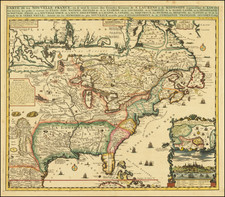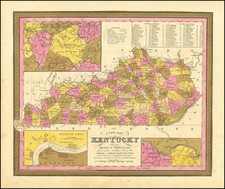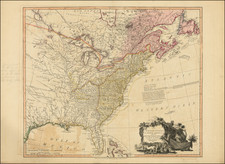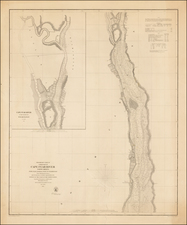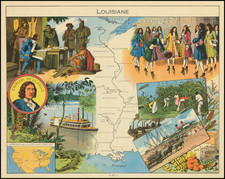Striking Second State Example of John Smith's Landmark Map of Virginia in Early Color, Only Second Known Example of a Separately-Issued Map
As noted by Burden, Smith's map is "one of the most important printed maps of America ever published and certainly one of the greatest influence. It became the prototype for the area for half a century." Burden goes so far as to say that the map's publication considerably influenced the success of the Virginia Colony itself. It also remains important for scholars of Native American cultures today. This example is a rare surviving example in early color and is also only the second surviving example known of a separately issued map.
The map's subject is announced triumphantly in a scroll banner that unfurls across the top of the map, just above the Royal coat of arms of James VI and I. To the right is a formidable Native American man identified as a "Sasquesahanough" Indian, a "Gyant like people." The man carries a long bow and a club and peers out inquisitively at the reader.
In the upper left corner is a scene of the Native American leader Powhatan holding council. He is sitting on a platform above his fellows who are grouped around a large fire. It is primarily the lands controlled by Powhatan depicted in the map, as evidenced by the letters "P-O-W-H-A-T-A-N" scattered across the terrain. The illustrations of Powhatan's Council and the "Sasquesahanough" Indian were derived from original drawings by John White, a supporter of colonization who had accompanied the initial Roanoke voyage.
At the bottom is an elaborate scale decorated by large dividers, seemingly proclaiming that English men with European technology have now measured, and therefore taken possession of, the land depicted. Just below the scale John Smith is identified as the discoverer and designer of this map, while William Hole is named as the engraver. The lack of a publisher indicates, as Edney argues, that this map was not meant for individual sale as a separate map, but was always to be included in a book or pamphlet, a hypothesis borne out by its subsequent print history (see below).
In the sea at the bottom of this west-oriented map is a large compass rose and a grand ship. Whereas the compass rose is functional, the rhumb lines radiating from it are mere decoration; this was not meant as a navigational aid for mariners.
Stretched along the bottom is a scale of latitude running from roughly 36 degrees to just over 41 degrees north, which is the area targeted for colonization by the English. Virginia, as defined in the revised Letters Patent drawn up by the English monarchy, ostensibly included the land between 30 and 48 degrees north latitude, but the English knew they could never hope to possess all that land unopposed by the French, Spanish, and Dutch.
As Edney again points out, it was typical for sea charts of this period to only contain latitude scales, as longitude was still nearly impossible to calculate accurately. However, it is less common on maps not intended for navigation. From state 4 onward, the map does contain a longitude scale. However, many surviving examples of the map have been trimmed close, so as to fit within a book.
Despite all of these embellishments, the main draw of the map is the detailed topography peppered with toponyms which would have been introduced to England for the first time in this map. Trees and hills also fill the space, making the land seem fertile and familiar. It is also not an empty space, for Native American villages abound, marked with huts, and small figures hunt with bows and arrows.
Smith's depiction of the Native America villages still serves as one of the primary sources for information on the region in the early seventeenth century. As Burden notes, Smith included 166 settlements, each of which provides an opportunity for historians to study.
Smith's map is also notable for the area it covers. As mentioned above, the region depicted is largely that controlled by Powhatan, also known as Tsenacommacah. Previous maps that included Virginia associated the name with varying places on the east coast of North America, from the Outer Banks of the Roanoke Colony to an island to an amorphous zone covering much of the Eastern Seaboard. The Virginia shown here, from the Chesapeake Bay in the east to the mountains in the west, is the Virginia we know today, and it is an area indelibly marked with the geography and story of John Smith.
Jamestown and the John Smith's explorations of Virginia
One December 6, 1606, the Susan Constant, Godspeed, and Discovery set sail to establish a settlement. They chose Jamestown as their site on May 31, 1607 and set about creating what would become the first permanent English settlement in North America. Shortly thereafter, the fleet's commander, Captain Christopher Newport, went to explore the region's rivers and mineral resources. He was accompanied by one John Smith (bap. 1580-1631).
Smith had been held in confinement for much of the voyage, but upon reaching Virginia he was elected to the governing Council. In December of 1607, Smith was taken prisoner by indigenous peoples and brought before the powerful Powhatan. This experience served as the inspiration for the vignette in the upper left corner of the map. Rather than be punished, or dramatically saved by Powhatan's daughter, Pocahontas, Smith was inducted into the tribe and then released. On August 10, 1608, Smith was elected President of the Council. He took on the considerable task of increasing the productivity of the colony and strengthening its defenses.
On several expeditions between 1607 and 1609, Smith and others explored the major rivers which flowed west into the Chesapeake Bay, recording the names of the Native American villages and peoples. The limits of his group's explorations are marked on the map with Maltese crosses. Beyond the crosses, Smith relied on Native American accounts to delineate territories further upriver, as he notes in the upper right of the map, "To the crosses hath bin discouerd what beyond is by relation."
In 1609, Smith was severely injured by a powder blast. He had to return to England to recuperate, sailing from Virginia on October 4, 1609. He would never again return to Virginia.
The publication of the map and subsequent states
Smith confronted suspicion on the part of the Virginia Company on his return to England. The Company also seems to have interfered with the publication of this map, as Smith had to publish it and his account of his travels through Joseph Barnes in Oxford as opposed to using a London printer. Smith employed William Hole to engrave the map, which debuted with Smith's pamphlet entitled A Map of Virginia. The map would not appear again for twelve years, when it was included, along with Smith's map of New England, in his landmark work, The Generall Historie of Virginia, New-England, and the Summer Isles (London: M. Sparke, 1624). The following year it was included in the fourth volume of Samuel Purchas' travel collection, Purchas His Pilgrimes.
As Verner has explained, there is some question as to whether the map is the work of Smith, who led most of the explorations, or the surveyor accompanying him, Nathaniel Powell. However, after a review of the available sources, Verner argued that there was not sufficient evidence to overturn the convention of attributing the map to John Smith. His name appears on it, it was included in two publications by him, and Purchas credits the map to Smith in his Pilgrimes.
The present example is an exceptionally rare second state of the map, although all the states are rare on the market. The states were established by Verner after a survey of 111 extant examples and listed by Burden as follows:
- State 1: No date, no coat of arms at bottom right (1612)
- State 2: 1606 date added in the scale of miles and 1607 date added below Powhatan illustration
- State 3: Smith's coat of arms added at bottom right, without motto
- State 4: Smith's motto added below his coat of arms, along with longitude markings
- State 5: Gunter's Harbour added along with other place names at the head of Chesapeake Bay
- State 6: Democrites Tree added lower left of the Royal coat of arms, two other new place names
- State 7: Page numbers 1692 and 1693 added at top corners (for appearance in Pilgrimes) (1625)
- State 8: Page 41 Smith added at lower right corner, with new place names
- State 9: Washborne C: appears just above the ship, with other changes
- State 10: Page numbers changed to 1690 and 1691
- State 11: Hair on the top of the Indian's head is cross-hatched
- State 12: Large plate crack running through ship, extending over 2/3 of the plate
The few surviving examples of the second state, including that in the Garret Library at Johns Hopkins, suggest that printing the map took some learning. First edition states at the Bodleian Library show the cross hatching in Powhatan's hut and in the waters are too dark, having been inked too heavily. From the second state onward, however, this over-inking was corrected.
Second State / Early Color / Separately Issued
This is an extraordinary example of the exceptionally rare second state of Smith's Virginia, made even more remarkable by its appearance in period color. This example was sold or distributed separately, not bound in a book, colored in the period, and then bound into a composite, or made-up collection of maps or prints. The oxidation of the old color is clearly visible on the back of the sheet and its antiquity has been confirmed by a highly regarded conservator. We are not aware of another example of the map in early color appearing on the market.
This map was clearly never bound into one of the three published works in which the map normally appears (Smith, A Map of Virginia, 1609; Smith, History of Virginia, 1612; Purchas, 1624). When bound into either of the last two works, the map included printed page numbers which are not present on this example (see list of states) and had severely trimmed margins. Most significant is the manuscript page number "177 [or 155]" in ink on the back in the upper right corner. This number clearly refers to the order in which the map was bound into the composite, and bears no relationship to the order in which it appeared in any of the three previously mentioned volumes.
We locate only a single example of the Smith map of Virginia bound into a composite work. Princeton has a manuscript volume compiled by the early Virginia adventurer, William Strachey, which includes a colored first state of Smith's map, an example used by Rand McNally & Co. as its 1961 Christmas card.
Rarity
The second state is a great rarity, with no copy located in Virginia. The addition of the dates (1606 and 1607) must have been made almost immediately after the map was initially published. Verner located just three examples of this state, each uncolored and bound into one of the three works mentioned above (Huntington Library, Garret Library, Harvard).
Woolridge argued that there was a surviving example of the second state with full margins and no folds, indicating it was separately issued, most likely one of those distributed personally by Smith. Most of the surviving states are closely-trimmed examples taken from books, like the three second state examples described above. The Woolridge example is reproduced in his Mapping Virginia (map 26). However, the present example described here means that there are two surviving examples of separately issued Smith maps, making this item even more exceptional.
This is one of the most important maps in the history of cartography and of North America. It represents the initial exploration by the founders of the first permanent English settlement in North America. It helped to define geographically the area still known as Virginia today and has proven a crucial tool for scholars interested in Native American history. This particular example is in exceptional old color, one of only two known separately issued maps, and has unusually wide margins.
Gwenda Morgan, “John Smith”, ODNB entry, online edition.
Richard W. Stephenson and Marianne M. McKee, eds., Virginia in Maps: Four Centuries of Settlement, Growth, and Development (Richmond: Library of Virginia, 2000).
The World Encompassed…(Baltimore: Trustees of the Walters Art Gallery, 1952)
William C. Woodridge, Mapping Virginia: From the Age of Exploration to the Civil War (Charlottesville: University of Virginia Press, 2012)









